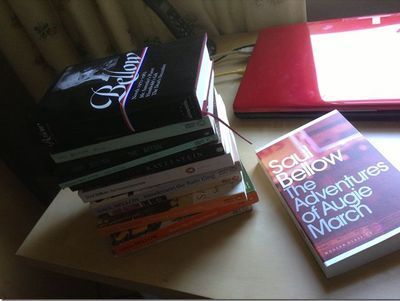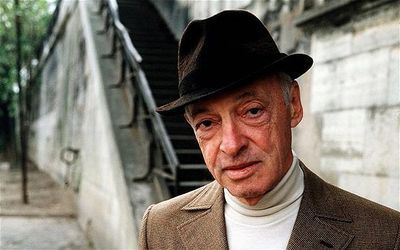Reading Saul Bellow
By ADRIAN TAHOURDIN
I have a confession
to make: I have yet to read The
Adventures of Augie March. Published in 1953, Saul Bellow’s first “big”
book was described by Martin Amis, Bellow’s most eloquent and fervent
reader-critic, as “the great American novel”. No real excuse not to have read
it then.
But I have read all of Bellow’s other novels. Reading Bellow has been like a long, broken
but hugely rewarding journey. I first became acquainted with his work twenty-five years
ago, partly prompted by Anthony Burgess’s influential book Ninety-Nine Novels: The best in English since 1939. (Burgess’s
hope was that someone would choose one of his works as the 100th –
A Clockwork Orange perhaps?) Burgess
opted for Bellow’s The Victim as one
of his two best novels for the year 1947, the other one being Malcolm Lowry’s
Under the Volcano (not read). He called Bellow’s second novel a “quiet
masterpiece”. At the time, that seemed an accurate assessment. I’m sure it still
applies.
For some
unfathomable reason – what dictates our reading patterns?, I wonder – I didn’t
read another Bellow for a further three years or so: Something To Remember Me By, which included the novellas The Bellarosa Connection and A Theft, as well as the wonderful title
story of rites of passage in 1930s Chicago. But several more years passed
before I had a serious attack of the Bellows: the novella Seize the Day, More Die of
Heartbreak (great title, great book), Dangling
Man (his first), Herzog, The Actual, and Henderson the Rain King. I wasn’t at all persuaded by this last book,
but ploughed my way diligently through it. I’m still baffled by the high status
it’s accorded.
Amis’s first
published collection of essays The
Moronic Inferno and Other Visits to America (1986) took its title from Humboldt’s Gift (1975): “Now the moronic
inferno had caught up with me”, says the narrator Charlie Citrine as he surveys
the ruins of his swanky Mercedes which has been smashed up with baseball bats
outside his Chicago apartment.
Meanwhile, in his
memoir Experience, Amis writes, of
Bellow’s last novel Ravelstein
(2000), “I have to keep reminding myself that the author was born, not in 1950
but in 1915” (he died in 2005). There is indeed a remarkable energy to the
book, published in Bellow’s eighty-fifth year. The phenomenon of writers
remaining near the top of their game well into their eighties is still pretty
rare (and perhaps restricted to the twentieth and now the twenty-first century). If one
excludes poets, only a few names come to mind: the leading figure of the nouveau roman Nathalie Sarraute was
still near her best in her nineties. Her fellow nouveau romancier Claude Simon published one of his finest (and
briefest) works Le Tramway at the age
of eighty-eight – a sunny, captivating and fictionalized account of the novelist’s
childhood in a seaside town in the south-west of France.
On the debit side,
Philip Roth, who recently turned eighty, has declared that he will not be writing
any more fiction. The late Gore Vidal disappointed many of his readers with a
slackly written and woefully under-edited follow-up, Point to Point Navigation, to his fascinating, waspish memoir Palimpsest (1995). It might have been
better if the second book had not seen the light of day, particularly as it
turned out to be Vidal’s last work.
But Ravelstein doesn’t flag; as a homage to
and undisguised portrait of Bellow’s late friend the academic Allan Bloom,
whose best-selling book The Closing of
the American Mind was such a divisive work when it appeared in 1987, it
brings out the flamboyance and slight preposterousness of this larger-than-life
figure. Bellow clearly held Bloom in the highest regard, and at one point has his narrator compare him favourably with Diderot: “’The Palais Royal’ – Ravelstein
gestured loosely toward it – ‘was where Diderot walked late every afternoon and
where he had his famous conversations with Rameau’s nephew. But Ravelstein was
by no means like the nephew – that music teacher and sponger. He was above
Diderot, too. A much larger and graver person . . .”. Really?!
“The main thing
about Chicago is that it’s not New York”, wrote Bellow, of the two cities at
the heart of his work (Montreal might be a third). A blog is no place for lit
crit (and I’m no expert on American fiction) but it seems to me that if you
want to learn about life in twentieth-century urban America, and the Jewish
experience in particular, as well as much else too, Bellow’s work should be the
first port of call. And it might be said that his peculiarly European sensibility both expands and deepens its qualities.
And of course
there’s the humour: one of my favourite characters is the shameless Pierre Thaxter
in Humboldt’s Gift, a literary con man, serial
adulterer and father of nine, who travels across the
Atlantic on a liner in first class – his mother picks up the tab – in spite of
the fact that he’s flat broke (significantly, Thaxter is Californian). Citrine
tells him:
“If I had no
cash, I’d ask my mother to put me in steerage. How much do you tip when you
get off the France in Le Havre?” I
asked him.
“‘I give the chief
steward five bucks.”
“You’re lucky to
leave the boat alive.”
“Perfectly
adequate,” said Thaxter. “They bully the American rich and despise them
for their cowardice and ignorance.”
I have a Library of
America edition of Novels 1970–1982,
a period that represents the high point of Bellow’s career, the possessively
titled trio Mr. Sammler’s Planet, Humboldt’s Gift and The Dean’s December. One thing that struck me about this otherwise
very handsome volume is the extraordinary number of typos it contains,
particularly as the reader is assured that the “texts are presented without
change, except for the correction of typographical errors”. Here’s just a
sample selection: “Punisment”, “Sannnler” for Sammler, numerous “he”s for “be”s
and “be”s for “he”s, “staff” for stuff and so on, as well as the comical “New World Symophony” – none of them, granted,
an impediment to comprehension, but still . . . . I imagine these errors will
now remain uncorrected.
(Writing as someone
whose shared responsibilities at the TLS
include making sure the paper goes to bed with its hands as clean as possible,
i.e. proofreading the pages – the weekly equivalent of proofing a 50,000 word
novel – I always react to typos spotted too late as if I’ve taken a blow to the
solar plexus. I’m determined never to let through weirdly common misspellings
such as “elegaic” and “pharoah”.)
In her newly
published Literary Miniatures
(translated by Teresa Lavender Fagan; Seagull Books, $20/£13), a collection of
interviews with (non-French) authors, Florence Noiville, editor of foreign
fiction for the weekly supplement Le
Monde des Livres, describes meeting Bellow near his Vermont fastness in
1995. He greets her with the question “Suis-je celui que vous attendiez?” – “Am
I the one you were expecting?” It is strange to hear French spoken in this
remote inn in Vermont"; but it’s a reminder of Bellow’s early Montreal
upbringing, his Paris sojourn in the late 40s, and enduring Francophilia. Later in
the piece he reveals that “J. D. Salinger lives on the other side of these
hills, in New Hampshire. He’s a bear. Doesn’t see anyone. Never goes out. Worse
than I am”.
Now, on to Augie March.
Peter Stothard's Blog
- Peter Stothard's profile
- 30 followers





